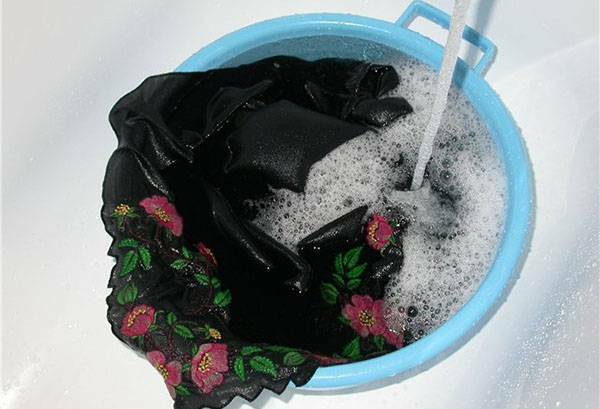Contents:
- What can not be washed in a washing machine?
- How do I prepare for the hand-washing process?
- How do I sort the contaminated items before hand washing?
- What is the water temperature required for manual washing?
- How to choose a means for hand washing?
- How does the manual washing process work?
Hand washing is not as popular as it used to be, because almost everyone has a washing machine at home. But in the event of a breakdown of the "assistant" you will have to work handles. Also, there are things that machine wash is contraindicated. Of course, in modern "washers" there is a delicate regime. But not on all machines it works correctly.

What can not be washed in a washing machine?
On the tags of some things there is an icon - a sketchy basin with water is shown schematically in which the hand is lowered. That's why he forces us to abandon the washing machine. In most cases, manufacturers are reinsured, so that in the event of a defect after machine washing, not be responsible. But sometimes the washing machine can actually disable the product. Also in the typewriter it is impossible to put things with some kinds of pollution.
What can not be washed in the typewriter?
- Things contaminated with oil products - gasoline, engine oil, kerosene. Getting on the rubber parts of the machine, they can corrode them. When the contamination is extensive, vapors of flammable substances can lead to an explosion.
- Clothes made of leather and leatherette. The product will lose shape and color.
- Thin lace items( if delicate washing is not provided).In normal mode, lace can tear.
- Products with a rigid form - suits, coats, hats. But washing in the basin is also not recommended. It's better to turn them in dry cleaners.
Unlike machine wash, you can manually erase everything. Well, or almost everything - except for things that require chemical treatment.

How do I prepare for the hand-washing process?
Having decided to wash by hand, first prepare everything you need:
- 2 basins;
- detergent;
- rinse aid;
- rubber gloves;
- contaminated things.
Place the bow so that you do not have to lean heavily. Otherwise, the back will get tired very quickly. You can put a wide board on the sides of the bathtub or put the basin on a chair.
Rubber gloves are mandatory if you want to keep your handles soft and healthy. Aggressive detergents corrode the upper layer of the skin, after which redness and cracks appear on the hands.

How do I sort the contaminated items before hand washing?
Things are sorted in the same way as machine wash. Principles of sorting are simple.
- White and colored linen are washed separately.
- Colored things are separated by colors - blue to blue, red to red.
- Products from delicate fabrics are erased separately from other things.
When hand washing, first wash lightly soiled things, after which more dark or stained products are placed in the same water. Water is changed as it gets dirty.
Please note!
If during washing water has become "color"( green, blue, red, yellow, black or other color) - your thing shed. Such water needs to be changed, otherwise the pigments will stain the fabric of the next product placed in the water. It is allowed to wash a product similar in color - at your discretion.

What is the water temperature required for manual washing?
The water temperature is selected not only based on the allowable wash temperature of the product. Water should not burn your hands. You can withstand a maximum of 50 ° C.
Often, the tags on products are cut off so that they do not rub the skin. The correct degree of water heating can be based on the type of fabric.
- Natural fabrics of vegetable origin - flax, cotton - are erased at any temperature and with any intensity. Things from them do not sit down, they do not stretch. Colored things rarely shed.
- Natural fabrics of animal origin - silk, wool. The water temperature is 30-40 ° C.Things from these fabrics are fastidious, they need to be washed carefully and practically not wrung out, but let the water drain.
- Viscose - washing in cold water is recommended. The washing temperature is not more than 30 ° C.Synthetic fabrics - lavsan, acrylic, lycra. The water temperature is 40-50 ° С.
- Combined fabrics( used most often) - cotton + nylon, wool + lavsan, etc. Wash temperature 40-50 ° С.
If you do not know what fabric your product is made from, wash it in warm water( about 30-35 ° C).

How to choose the means for manual washing?
For manual washing, select only the products on which there is a corresponding mark.
- Powders for hand washing contain less aggressive ingredients, they are more gentle to the skin of hands. Make sure that the powder is completely dissolved in water. Only then put the thing in the foam solution. The granules of the powder are very concentrated. Getting on the cloth, they eat it.
- Gel for washing is a good solution. It dissolves rapidly in water. Especially this property is important for products requiring hand washing at low temperatures. Powder in cold water dissolves longer than in warm water.
- Household soap is an unfairly forgotten detergent. It perfectly removes complex contaminants, sparing the skin of hands, and does not cause allergies. Particularly topical is the use of soap for underwear, which is in close contact with the skin.
- Oxygen bleach is used to remove stains from the fabric. Eliminates any organic dirt, while maintaining the color of the laundry. Pay attention - oxygen bleach happens for white and color linen. Do not confuse.
- Chloride bleach is used only for white linen made from natural fabrics. It removes stains and greyness. Chloride bleach is very aggressive, and chlorine vapor is harmful. Use it only when necessary.
It is important to know
Artificial fabrics - lavsan, lycra, acrylic - must not be washed with alkali containing agents. These include some powders( see the composition) and a laundry soap that contains sodium carbonate.
Natural fabrics of animal origin - wool, silk - can not be washed with enzymes that decompose proteins. Choose special means that things serve you as long as possible.

How does the manual washing process work?
How to wash by hand? The correctly executed washing process looks like this.
- Choose a place to wash. It should be with access to water. You can wash in the bathroom or on the street near a column or a well. In the absence of hot water will have to carry hot water from the kitchen.
- Pour water of the appropriate temperature into the basin. Add the powder or gel in the amount specified in the instructions. Stir by hand until the foam forms. Make sure that the crystals of the powder are completely dissolved. If you decide to wash with soap, just put it near the basin.
- If clothing requires heavy washing, put things in foaming water and wait 15-20 minutes. Strongly soiled things can be soaked for 2-3 hours, bed linen - at night.
- Rub the laundry with your hands not only in places of dirt, but also all over the surface. You can use a washing board for washing. If you wash with soap, lather a thing first. You can also use soap in addition to the powder.
- Remove the clothes from the basin, slightly wring out, and place in a rinse bath.
- Rinse the laundry is recommended 2 times - in warm and cold water. First rinse with warm water, trying to remove as much foam as possible. Then repeat the process with cold water.
- Lightly squeeze out a thing by removing as much water as possible. Do not overdo it so that the thing does not deform. Delicate things can be wrapped in a dry towel instead of squeezing, taking water.
- Hang up items or lay them on a dryer. If you dry your clothes in the sun, do not forget to turn it inside out. Remember that products made of wool and cashmere stretch when vertical drying. If there is no dryer, spread the towel on the table and put the thing on it.
- Wait until the thing dries, and remove it from the rope or dryer.
Now your stuff is clean.
Council
To keep your things freeze during the winter when drying on the street, add a handful of salt to the water during the last rinse.
Hand wash is a laborious job. Armed with knowledge to simplify this process, and washing will cease to be unloved occupation.



